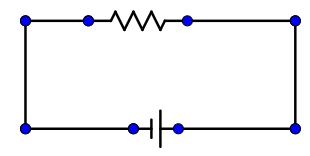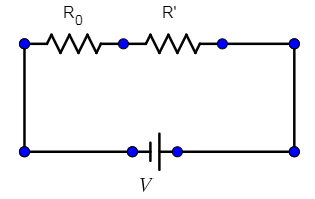
To decrease the range of an ammeter, its resistance needs to be increased. An ammeter has resistance $R_0$ and range I. Which of the following resistance can be connected in series with it to decrease its range to I/n?
A. $\dfrac{R_0}{n}$
B. $\dfrac{R_0}{(n-1)}$
C. $\dfrac{R_0}{(n+1)}$
D. None of these.
Answer
579.9k+ views
Hint: We need to find the resultant current when a resistor is connected in series. In a series circuit, the current is common. By applying the ohm’s law to the series circuit, we find the resistance.
Formula used:
Ohm’s law: When a potential difference of V volts is applied to a resistance R and I current flows through it the relationship of V and I can be written as:
V=IR
Complete answer:
An ammeter is a device which measures the amount of current in the circuit when it is connected in series. In an analog ammeter, we have a scale that goes from a minimum (usually 0 units) to a maximum value (says I in the question). Thus, the maximum value that our ammeter depicts is I (units) when it has a resistance of $R _0$. Consider this circuit as equivalent to a situation when I am flowing through a resistance of $R _0$ when a battery of V volts is connected.

V=I$R _0$
We need to find a resistance to be attached in series with this resistance $R _0$ so that the current reduces to I/n in the circuit (we still use our V volts supply). So now, the battery of ours has to give current to two resistances R and R’:

V=$\dfrac{I}{n}$ ($R _0$ +R’)
Thus, we must equate the V in both circuits to get our value of R’:
IR0=$\dfrac{I}{n}$ ($R _0$ +R’)
$R _0$ -$\dfrac{1}{n}$ $R _0$ =$\dfrac{R’}{n}$
This gives,
(n-1) $R _0$ =R’
So, the correct answer is “Option D”.
Note:
An ammeter is connected in series in a circuit so the resistance it has is accounted for in series in the circuit whereas if there were a voltmeter, it would have had a resistance in parallel with the circuit, across some other resistance.
Formula used:
Ohm’s law: When a potential difference of V volts is applied to a resistance R and I current flows through it the relationship of V and I can be written as:
V=IR
Complete answer:
An ammeter is a device which measures the amount of current in the circuit when it is connected in series. In an analog ammeter, we have a scale that goes from a minimum (usually 0 units) to a maximum value (says I in the question). Thus, the maximum value that our ammeter depicts is I (units) when it has a resistance of $R _0$. Consider this circuit as equivalent to a situation when I am flowing through a resistance of $R _0$ when a battery of V volts is connected.

V=I$R _0$
We need to find a resistance to be attached in series with this resistance $R _0$ so that the current reduces to I/n in the circuit (we still use our V volts supply). So now, the battery of ours has to give current to two resistances R and R’:

V=$\dfrac{I}{n}$ ($R _0$ +R’)
Thus, we must equate the V in both circuits to get our value of R’:
IR0=$\dfrac{I}{n}$ ($R _0$ +R’)
$R _0$ -$\dfrac{1}{n}$ $R _0$ =$\dfrac{R’}{n}$
This gives,
(n-1) $R _0$ =R’
So, the correct answer is “Option D”.
Note:
An ammeter is connected in series in a circuit so the resistance it has is accounted for in series in the circuit whereas if there were a voltmeter, it would have had a resistance in parallel with the circuit, across some other resistance.
Recently Updated Pages
Master Class 12 English: Engaging Questions & Answers for Success

Master Class 12 Business Studies: Engaging Questions & Answers for Success

Master Class 12 Economics: Engaging Questions & Answers for Success

Master Class 12 Social Science: Engaging Questions & Answers for Success

Master Class 12 Maths: Engaging Questions & Answers for Success

Master Class 12 Chemistry: Engaging Questions & Answers for Success

Trending doubts
What are the major means of transport Explain each class 12 social science CBSE

Which are the Top 10 Largest Countries of the World?

Draw a labelled sketch of the human eye class 12 physics CBSE

Explain sex determination in humans with line diag class 12 biology CBSE

The pH of the pancreatic juice is A 64 B 86 C 120 D class 12 biology CBSE

Explain sex determination in humans with the help of class 12 biology CBSE




